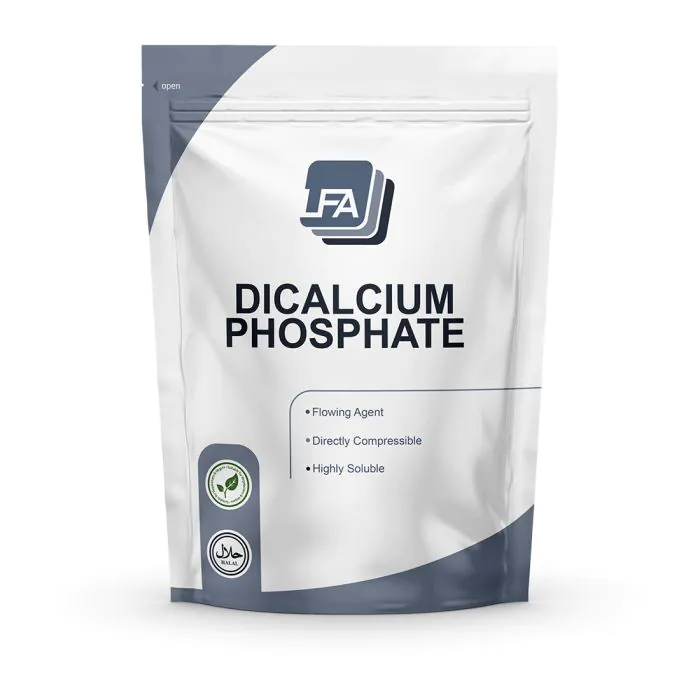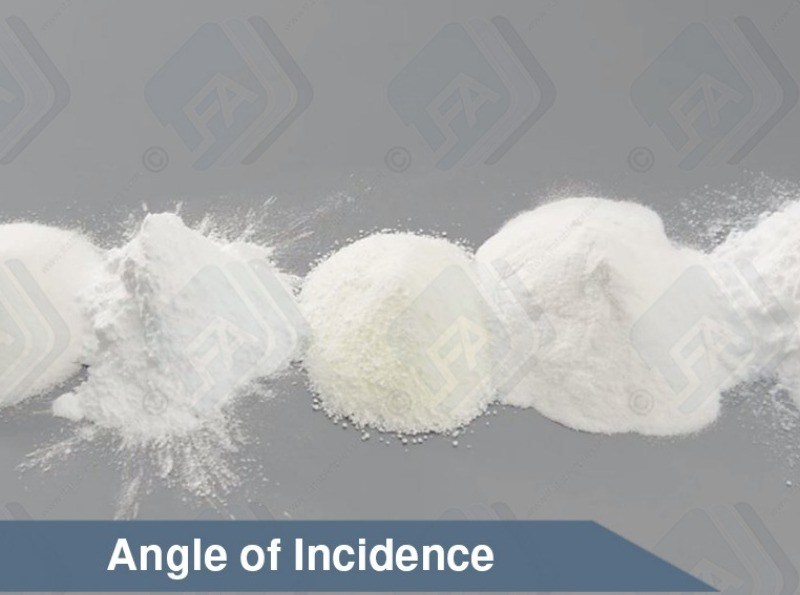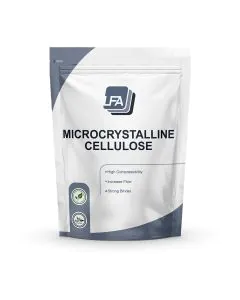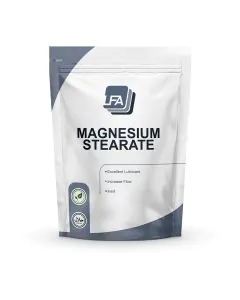El fosfato dicálcico es un ingrediente de una gama de distintos productos. Se usa en la producción de tabletas y cápsulas como "agente fluidificante". El fosfato dicálcico viene en distintos tamaños de malla. Los grados más gruesos que ofrecemos fluyen bien y tienen una excelente compresibilidad.
La fluidez es un elemento crucial del proceso de fabricación. Asegura que sus ingredientes pasarán sin problema por la máquina. Además, garantiza que su producto final tendrá ingredientes consistentes. Así sabrá que todas las tabletas sean iguales.
La compresibilidad es la facilidad con la que un polvo se transforma en una tableta sólida. El fosfato dicálcico de LFA es directamente compresible. El uso de excipientes como el fosfato dicálcico reduce el esfuerzo necesario para crear nuevas fórmulas.
El fosfato dicálcico es altamente soluble en ácido cítrico y citrato de amonio. Su ph es de 6,5 a 7. Debido a su alcalinidad, no funcionará bien con otros principios activos ácidos. Las propuedades aglutinantes del fosfato dicálcico son solo moderadas. Por tanto, debe utilizarse junto con otros excipientes.
El fosfato dicálcico pasa fácilmente a través del sistema digestivo. Tiene muchas utilidades distintas, y es un suplemento alimenticio por sí mismo. Se incluye a menudo en cereales para desayuno, productos de harina y fideos. Se usa también como agente antiaglomerante, ya que puede absober una pequeña cantidad de humedad. Además, es una fuente de fósforo mineral que se utiliza a menudo en dietas orgánicas. Otro uso prominente del fosfato dicálcico es la alimentación animal. Contribuye al metabolismo animal, y acelera el crecimiento y el desarrollo.
El manejo correcto del fosfato dicálcico es imprescindible para garantizar la seguridad y calidad del producto. Este producto puede irritar los ojos y su inhalación puede causar malestar en el pecho. Utilice siempre protección ocular, guantes y mascarilla cuando maneje este producto. Almacene siempre el fosfato dicálcico en un contenedor hermético y a temperatura moderada. Evite exponerlo a la humedad y a temperaturas extremas. Un almacenamiento incorrecto puede afectar a la dureza de sus tabletas con el paso del tiempo.
El fosfato dicálcico es un eficaz agente fluidificante, que añade nutrientes a su fórmula. Puede añadirlo a muchos alimentos como suplemento, para contribuir al bienestar tanto humano como animal. El fósforo y el calcio mejoran las funciones corporales de muchas maneras si se incorporan a la dieta del consumidor. Este es un producto conocido por el consumidor, y será un añadido perfecto a sus tabletas.
El fosfato dicálcico de LFA se suministra en forma de polvo cristalino. Es blanco o grisáceo, inodoro y fluye libremente.
Escribir Su propia reseña
Are all excipients safe for all ages to consume?
Yes, it does not matter what age, size or sex the person consuming the products is. It is, however, important to check the intolerance data.
Are all the excipients safe for human consumption?
Yes, all of the excipients are safe for human or animal consumption. There are some precautions that should be taken when handling them and there are some people that might have intolerances to some of them. Information on this can be found in the products MSDS and Intolerance Data Sheet. This can be found in this section for every excipient.
Are there any known allergens or health risks?
¿Son sus excipientes naturales?
Sí, todos nuestros excipientes son extraídos de fuentes naturales. Para obtener más información, por favor visite las páginas de los productos individuales.
Can I get a better price for excipients than is listed on the website?
Yes, we have bulk pricing for all of our excipients, and these can be found in this section. We offer bulk in 500 kg, 1 ton, 2 ton and 5 ton lots. The prices are set on these quantities as these are the amounts that will fit on pallets.
Can I have a CoA for my Excipient?
Yes. CoA stands for Certificate of Analysis this is also known some times as an MSDS (Material Safety Data Sheet) all of the information contained in a CoA is inside the MSDS for every LFA product which is emailed to you after purchase.
¿Puedo producir tabletas sin excipientes?
Es poco probable que usted sea capaz de producir tabletas sin usar excipientes. Ciertos productos se unen sin excipientes, pero luego no fluyen a través de la máquina. Le recomendamos que utilice Firmapress porque funciona con el 99% de los productos
Dissolving rate? Any known factors that can affect the rate, speed up or slow down the breakdown of a tablet?
Yes. There are two things at play here. You can get hygroscopic and hydrophobic excipients. Hygroscopic means that they take on water quickly, while hydrophobic means that they repel water.
There are products know as supper disintegrants. These products help the breakdown of tablets. At the moment LFA does not sell any supper disintegrants.
Magnesium stearate is hydrophobic this means that it will slow the breakdown of a tablet.
However, it is used in such small amounts that most of the time it will not make a difference to our customer's products. If they would like to be sure then they should conduct what is known as a disintegration test.
Do any of the excipients increase the speed of damage to tooling? i.e. more granular?
Yes, Dicalcium Phosphate, if used in high amounts, will cause more damage to tooling than just Firmapress or MCC. However, there are not many situations in which this would be a good idea.
How long is the storage period of each excipient? What is the shelf life?
Firmapress - 2 years form batch date.
Dextrose - 3 years from batch date.
Dicalcium Phosphate - 3 years from batch date.
Microcrystalline Cellulose -
Magnesium stearate -
Lactose - 2 years from batch date.
Silica Dioxide - 2 years from batch date.
How should I clean contact parts that have come into contact with my excipients or active ingredients?
here are 6 steps that should be followed as a general rule of thumb when cleaning contact surfaces that have come into contact with powders:
Dry Clean - First you need to remove as much of the dry powder as possible. You can do this using a hover/vacuum. Make sure that the vacuum you are using has a filter good enough to handle fine dust.
Wet Clean - Next you need to perform a wet clean. This can be done with warm water and soap or if available an ultrasonic cleaner.
Rinse - Next you need to rinse off any soap with potable water (drinking water). You do not have to do this if you used an ultrasonic cleaner in the last step. It is important to ensure that all parts are thoroughly dried immediately after washing to avoid any rusting.
Sanitise - Next you need to sanitise the surface. This step is recommended by the FDA. There are a number of sanitising solutions available designed to be applied and left on.
Lubricate - You now need to lubricate any parts that require it. This should be with the appropriate grade oil or grease considering your use and greasing chart. Store - Finally store any of the parts in a cool dry place. If you are storing them on the machine then make sure the machine is in a temperature controlled environment with low humidity.
¿Cuál es la diferencia entre el rango de los excipientes?
Ofrecemos celulosa microcristalina, estearato de magnesio, fosfato dicálcico y Firmapress en nuestra gama de excipientes.
La celulosa microcristalina es un aglutinante que consigue que el polvo se una correctamente para producir una buena pastilla.
El fosfato dicálcico es un agente de flujo y ayuda a mover los ingredientes a través de la máquina antes de que se compriman.
El estearato de magnesio es un lubricante seco y no solo ayuda de nuevo con el movimiento de los ingredientes a través de la máquina, sino que también ayuda con la expulsión de las tabletas de la máquina. Por favor, tenga en cuenta que el estearato de magnesio no hará de aglutinante por sí solo.
Firmapress es un excipiente multiuso. Es una mezcla de celulosa microcristalina, estearato de magnesio y fosfato dicálcico.
What is the mesh size of your excipients? etc.
Dextrose - approx 100 mesh
Dicalcium Phosphate - approx 100 mesh
Microcrystoline Cellulose - approx 120-200
Magnesium sterate -
Lactose - 80 mesh
Silica Dioxide -
Firmapress - 100-200 mesh
What kind of agent is each excipient?/ What is the main use of each excipient?
Dextrose - Sweetener, binding agent, good for chewable tablets or candy.
Microcrystalline Cellulose - Binder, filling agent. Good at binding tablets and making them bigger. It can also be used as a filler for capsules.
Magnesium stearate - Dry Lubricant. This stops products from getting stuck to the tooling. It can also help with powder flow issues and caking issues.
Lactose - Binder, sweetener and bulking agent. It has a large mesh so it flows well but most people do not like it because of the intolerance issues.
Silica Dioxide - Flowing agent. This assist powders in flowing smoothly through the machines. It also helps with cacking issues where powders get stuck to the machine.
What kind of condition should excipients be stored in?
Firmapress - 2 years form batch date.
Dextrose - 3 years from batch date.
Dicalcium Phosphate - 3 years from batch date.
Microcrystalline Cellulose -
Magnesium stearate -
Lactose - 2 years from batch date.
Silica Dioxide - 2 years from batch date.
Which excipient should I add if the product doesn't bind well?
If your product does not bind well then we would recommend using MCC. This can be used in any % the limiting factor is the size of the tablet.
If the amount of MCC you would have to use would be too much or if you do not want to use MCC then you have 3 other options: Ask your supplier for a directly compressible or tabletable grade of your product. Spray dry your product. Wet granulate your product.
Which excipient should I add if the product is sticky?
If your product is sticky then you will need to add a dry lubricant to your mix. For this, we recommend magnesium stearate.
We do not recommend that you add more than 1% to the mix as more than this can cause capping. If your product is still sticky at this point then we would recommend looking into granulation.
Which excipient should I add if the product/API is clumpy?
If your product or API is clumpy then you will need to add an anticaking agent. For this, we recommend silicon dioxide. We only recommend adding a maximum of 2% of this to the mix










